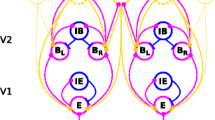Abstract.
Segregation of sensory inputs into separate objects is a central aspect of perception and arises in all sensory modalities. The figure-ground segregation problem requires identifying an object of interest in a complex scene, in many cases given binaural auditory or binocular visual observations. The computations required for visual and auditory figure-ground segregation share many common features and can be cast within a unified framework. Sensory perception can be viewed as a problem of optimizing information transmission. Here we suggest a stochastic correlative firing mechanism and an associative learning rule for figure-ground segregation in several classic sensory perception tasks, including the cocktail party problem in binaural hearing, binocular fusion of stereo images, and Gestalt grouping in motion perception.
Similar content being viewed by others
References
J-M Alonso WM Usrey RC Reid (1996) ArticleTitlePrecisely correlated firing in cells of the lateral geniculate nucleus Nature 383 815–819
SM Anstis (1980) ArticleTitleThe perception of apparent movement Phil Trans R Soc Lond B290 153–168
M Arbib (Eds) (1995) The handbook of brain theory and neural networks MIT Press Cambridge, MA
JJ Atick (1992) ArticleTitleCan information theory provide an ecological theory of sensory processing Network 3 213–251 Occurrence Handle10.1088/0954-898X/3/2/009
DH Ballard GE Hinton TJ Sejnowski (1983) ArticleTitleParallel visual computation Nature 306 21–26
S Becker GE Hinton (1992) ArticleTitleA self-organizing neural network that discovers surfaces in random-dot stereograms Nature 355 161–163
AJ Bell TJ Sejnowski (1995) ArticleTitleAn information-maximization approach to blind separation and blind deconvolution Neural Comput 7 1129–1159
BS Blais N Intrator H Shouval LN Cooper (1998) ArticleTitleReceptive field formation in natural scene environments: comparison of single cell learning rules Neural Comput 10 1797–1813
AS Bregman (1990) Auditory scene analysis MIT Press Cambridge, MA
GD Brown S Yamada TJ Sejnowski (2001) ArticleTitleIndependent component analysis at the neural cocktail party Trends Neurosci 24 54–63
Chen Z, Haykin S (2004) Figure-ground segregation in sensory perception using a stochastic correlative learning rule. Technical Report, Adaptive Systems Lab, McMaster University, Hamilton, Canada
EC Cherry (1953) ArticleTitleSome experiments on the recognition of speech, with one and two ears J Acoust Soc Am 25 975–979
JE Cook (1991) ArticleTitleCorrelated activity in the CNS: a role on every timescale? Trends Neurosci 14 397–401
JJ Eggermont (1990) The correlative brain Springer Berlin Heidelberg New York
DJ Field (1994) ArticleTitleWhat is the goal of sensory coding? Neural Comput 6 559–601
S Geman D Geman (1984) ArticleTitleStochastic relaxation, Gibbs distributions, and the Bayesian restoration of images IEEE Trans Pattern Anal Mach Intell 6 721–741 Occurrence Handle0573.62030
S Grossberg E Mingolla (1985) ArticleTitleNeural dynamics of perceptual grouping: textures, boundaries and emergent segmentations Percept Psychophys 38 141–171
E Harth E Tzanakou (1974) ArticleTitleAlopex: a stochastic method for determining visual receptive fields Vision Res 14 1475–1482
E Harth KP Unnikrishnan AS Pandya (1987) ArticleTitleThe inversion of sensory processing by feedback pathways: a model of visual cognitive functions Science 237 184–187
S Haykin Z Chen S Becker (2004) ArticleTitleStochastic correlative learning algorithms IEEE Trans Signal Process 52 2200–2209
DO Hebb (1949) The organization of behavior Wiley New York
A Hyvärinen J Karhunen E Oja (2001) Independent component analysis Wiley New York
B Julesz (1971) Foundations of cyclopean perception University of Chicago Press Chicago
S Kirkpatrick CG Gelatt MP Vecchi (1983) ArticleTitleOptimization by simulated annealing Science 220 671–680 Occurrence Handle85f:90091
P König AK Engel (1995) ArticleTitleCorrelated firing in sensory-motor systems Curr Opin Neurobiol 5 511–519
M Livingstone D Hubel (1988) ArticleTitleSegregation of form, color, movement, and depth: anatomy, physiology, and perception Science 240 740–749
S Makeig T-P Jung AJ Bell D Ghahremani TJ Sejnowski (1997) ArticleTitleBlind separation of auditory event-related brain response into independent components Proc Natl Acad Sci USA 94 10979–10984
D Marr T Poggio (1976) ArticleTitleCooperative computation of stereo disparity Science 194 283–287
D Marr T Poggio (1979) ArticleTitleA computational theory of human stereo vision Proc R Soc Lond B 204 301–328
KD Miller (1990) NoChapterTitle MA Gluck DE Rumelhart (Eds) Neuroscience and connectionist theory Erlbaum Hillsdale, NJ 267–353
BA Olshausen DJ Field (1996) ArticleTitleEmergence of simple-cell receptive field properties by learning a sparse code for natural images Nature 381 607–609
RP Rao (1999) ArticleTitleAn optimal estimation approach to visual perception and learning Vision Res 39 1963–1989
W Singer (1993) ArticleTitleSynchronization of cortical activity and its putative role in information processing and learning Annu Rev Physiol 55 349–374 Occurrence Handle10.1146/annurev.ph.55.030193.002025 Occurrence Handle1:STN:280:ByyB387htV0%3D Occurrence Handle8466179
O Sporns G Tononi GM Edelman (1991) ArticleTitleModeling perceptual grouping and figure-ground segregation by means of active reentrant connections Proc Natl Acad Sci USA 88 129–133
E Tzanakou (2000) Supervised and unsupervised pattern recognition CRC Press Roca Raton, FL
E Tzanakou R Michalak E Harth (1979) ArticleTitleThe Alopex process: visual receptive fields by response feedback Biol Cybern 35 161–174
S Ullman (1979) The interpretation of visual motion MIT Press Cambridge, MA
KP Unnikrishnan KP Venugopal (1994) ArticleTitleAlopex: a correlation-based learning algorithm for feedforward and recurrent neural networks Neural Comput 6 469–490
Verri A, Straforini M, Torre V (1992) Computational aspects of motion perception in natural and artificial vision systems. Phil Trans R Soc Lond B pp 429–443
C Malsburg Particlevon der W Schneider (1986) ArticleTitleA neural cocktail-party processor Biol Cybern 54 29–40
C Malsburg Particlevon der (1999) ArticleTitleThe what and why of binding: the modeler’s perspective Neuron 24 95–104
AL Yuille NM Grzywacz (1988) ArticleTitleA computational theory for the perception of coherent visual motion Nature 335 71–74
Author information
Authors and Affiliations
Corresponding author
Rights and permissions
About this article
Cite this article
Chen, Z. Stochastic correlative firing for figure-ground segregation. Biol Cybern 92, 192–198 (2005). https://doi.org/10.1007/s00422-005-0544-4
Received:
Accepted:
Published:
Issue Date:
DOI: https://doi.org/10.1007/s00422-005-0544-4




